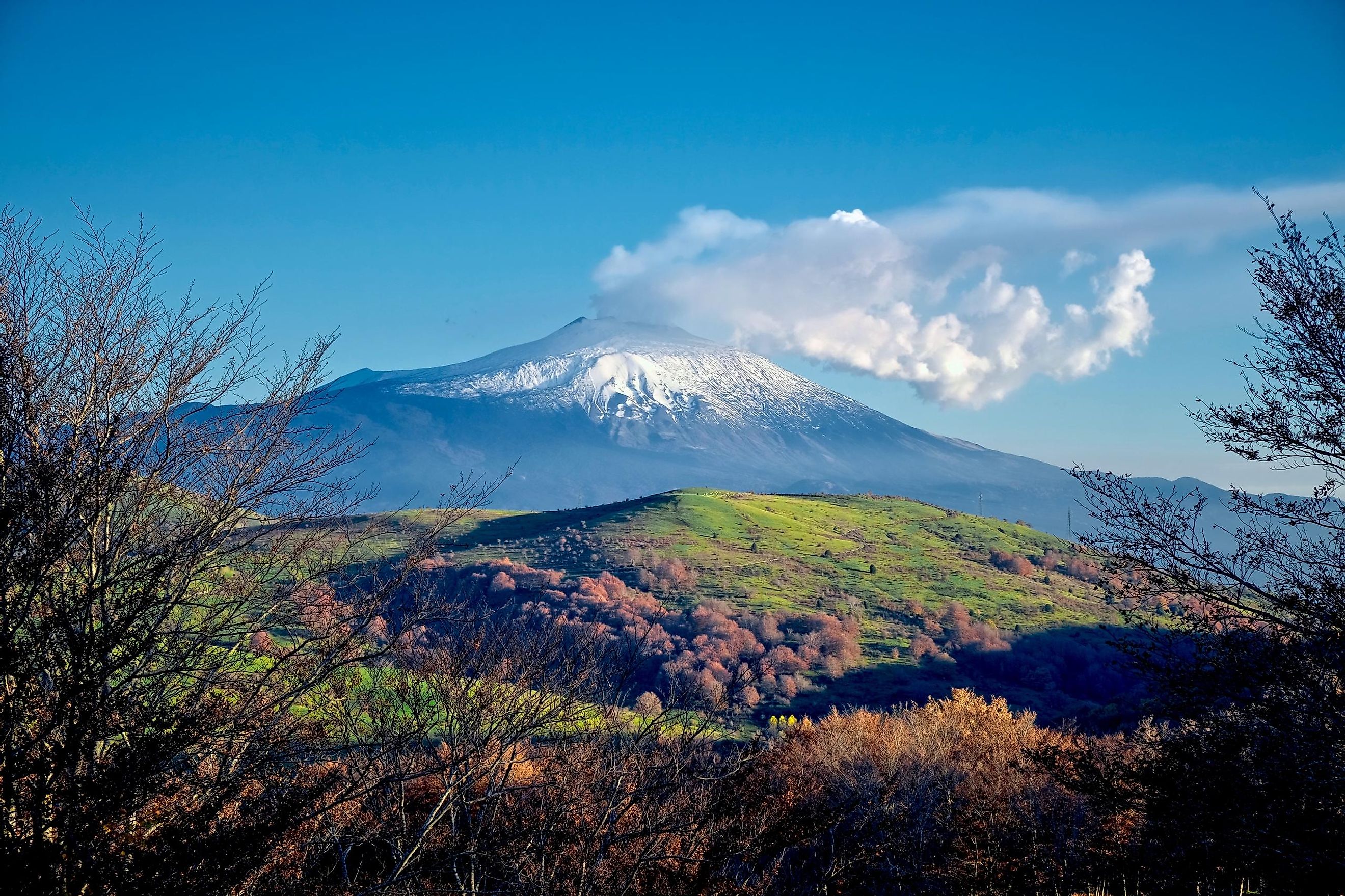
Mount Etna, Sicily
Also known by its Latin name ‘Aetna,’ Mount Etna is an active stratovolcano situated in the Metropolitan City of Catania on the eastern coast of the Italian island of Sicily. The name ‘Etna’ has been derived from the Greek word ‘aitho,’ which means ‘I burn.’ Though the summit height varies with eruptions, Mount Etna, with a current elevation of 11,014 ft, is one of Europe’s tallest active volcanoes and Italy’s highest peak located south of the Alps. Due to its recent volcanic activities and closeness to densely populated areas, the United Nations designated Mount Etna as a Decade Volcano.
Origin Of Name And Mythology Of Mount Etna
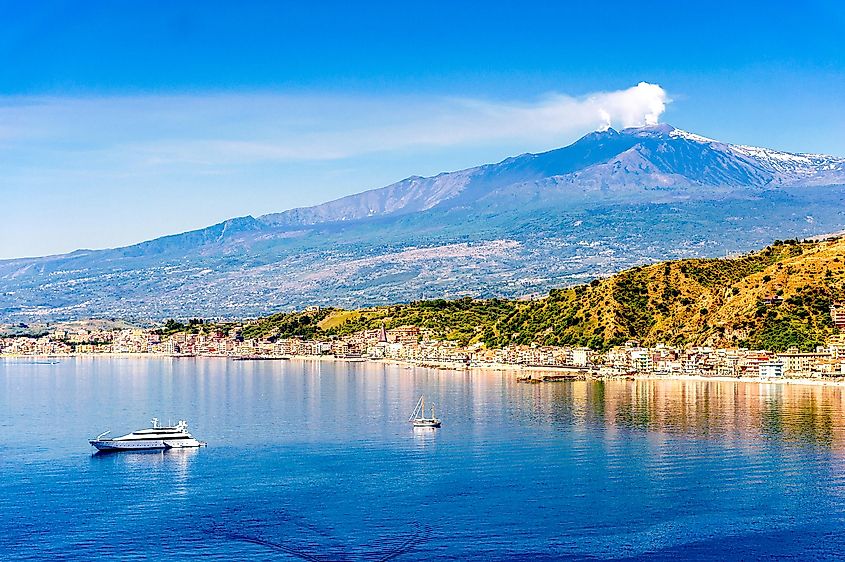
Some sources believe that the mountain’s name has been derived from the native Phoenician term attuna, which meant “chimney” or “furnace.” In the Sicilian language, the mountain is known as Muncibbeddu, while in the Italian language, it is known as Mongibello, which means “beautiful mountain.” Currently, the name Mongibello refers to the Mount Etna area, which contains the two central craters that are placed on the volcanic cone’s northeastern and southeastern sides. According to Greek mythology, the deadly monster Typhon has been trapped underneath this volcanic mountain by Zeus – the Greek God of Sky and Thunder, and his restlessness is considered to be the primary cause of the eruptions. In addition, both the Greek and Roman mythologies state that the Roman Fire God Vulcan, called Hephaestus by the Greeks, kept his blacksmithing forge under Mount Etna.
Geography Of Mount Etna
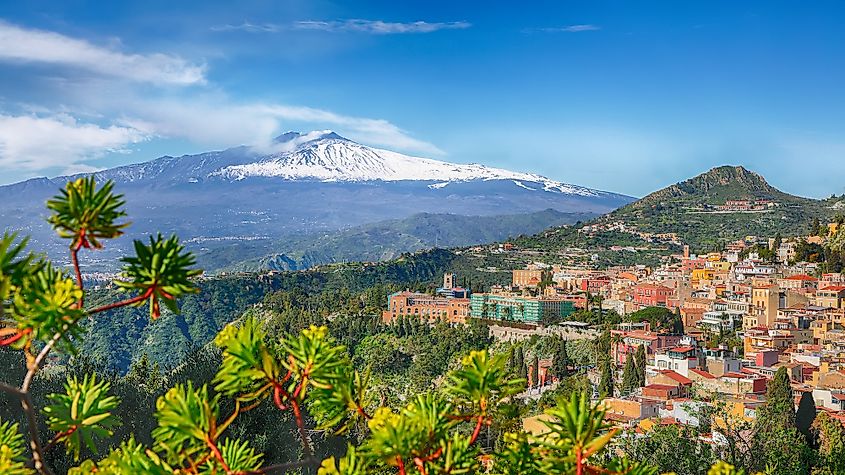
A UNESCO World Heritage Site, Mount Etna, located above the convergent plate boundary between the African and Eurasian Plates, is one of the most active volcanoes in the world. Like all other active volcanoes, the elevation of Mount Etna also varies significantly. The volcano's height increases due to depositions during eruptions and decreases due to the periodic collapse of the rim of the volcanic crater. Mount Etna erupted so much volcanic material over six months in 2021 that its height has been increased by about 100 ft, and the southeastern crater is currently considered the volcano’s tallest part.
Situated between the cities of Catania and Messina on Sicily Island, Mount Etna encompasses an area of approximately 459 sq. mi, with its basal diameter measuring about 87 miles. This makes Etna the biggest among Italy’s three active volcanoes and more than two-and-a-half times the height of Mount Vesuvius, the next biggest active volcano. Only Mount Teide, located on the Tenerife Island of Spain’s Canary Islands, surpasses Mount Etna in the entire European-North African region to the west of the Black Sea.
Placed one above the other, Mount Etna features three ecological zones, each having its own characteristic vegetation. The fertile volcanic soil of the mountain supports extensive agricultural activities. Spread across the mountain’s lowest ecological zone and the vast plains of Catania are numerous orchards, olive groves, vineyards, and citrus plantations. Approximately three-quarters of Sicily's food requirements are estimated to be supplied by this fertile region around Mount Etna.
Many densely populated settlements are located on the mountain’s lower slopes which become less frequent as one moves higher. The mountain grows steeper with increased elevation, and the slopes are covered with oak, chestnut, birch, beech, and pine forests. At over 6,500 ft elevations, the slopes are covered by fragments of lava, ash, and sand, as well as a few local plants like Spino Santo, which form bushes about 1 yard high.
Geological History Of Mount Etna
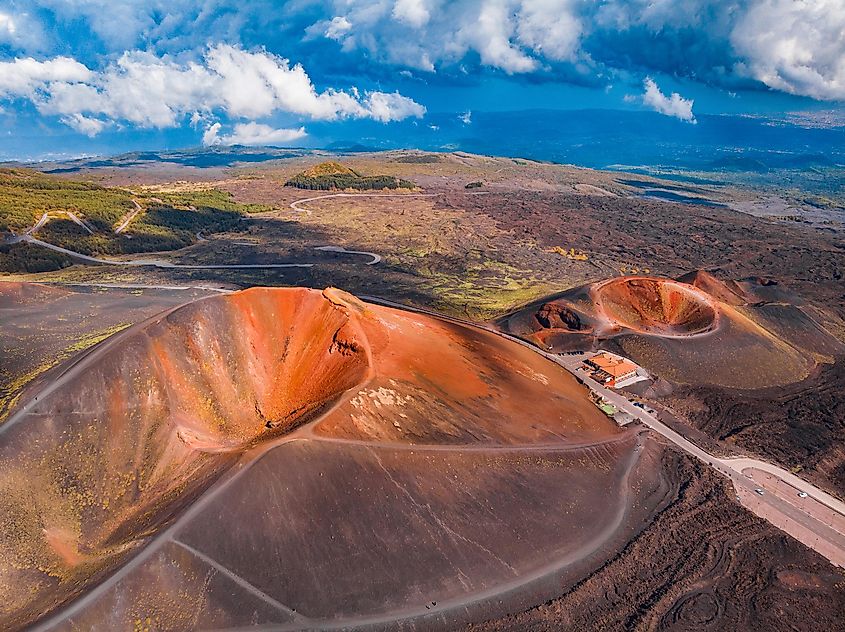
The geological characteristics of Mount Etna have revealed that this volcanic mountain has been active for about the last 2.6 million years, i.e., since the end of the Neogene Period. It is believed that about 500,000 years ago, the first volcanic activity took place, with eruptions occurring under the sea off Sicily’s ancient coastline. The volcanic activities that began in the southwestern part of the summit about 300,000 years ago shifted to the current activity center about 170,000 years ago. The successive eruptions during this period helped in the formation of the first significant volcanic edifice. However, the mountain’s growth was interrupted by frequent major eruptions, eventually leading to the summit's collapse and the formation of calderas.
Some highly explosive eruptions took place approximately 35,000 to 15000 years ago, producing large pyroclastic flows and extensive deposits of ignimbrite. A catastrophic collapse of the mountain’s eastern flank generated a devastating landslide, which created an enormous depression known as “Valle del Bove” along the side of the volcano. According to a study published in 2006, this event took place around 8000 years ago and produced a massive tsunami that left its mark in many places on the eastern shores of the Mediterranean Sea. Over the years, the valley’s steep walls have experienced several collapses. The most recent collapse is believed to have occurred around 2000 years ago, eventually leading to the creation of the Piano Caldera. Current studies have also revealed that Mount Etna massif is sliding at an average rate of 0.55 inches yearly towards the Mediterranean Sea.
History Of The Volcanic Eruptions Of Mount Etna
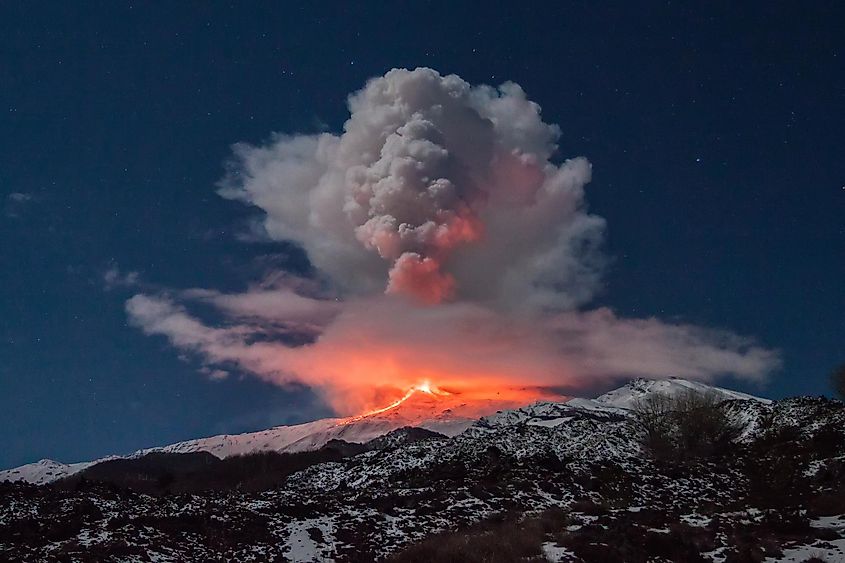
Almost continuous eruptive activities from the five distinct summit craters and frequent lava eruptions from more than 300 vents ranging from small holes to giant craters on the flanks characterize Mount Etna Stratovolcano. Although the highly explosive summit eruptions rarely threaten the inhabited areas around the volcano, they are very much threatened by the flank eruptions, which can extend downwards close to the inhabited areas. For the last 2,700 years, the exceptional volcanic activities of Mount Etna have been well-documented by humans, making it one of the most extended documented historical volcanism records in the world.
The ancient Greek historian Diodorus Siculus was the first to record the eruption of Mount Etna. Successive eruptions were noted by the old poet Hesiod and the Greeks Aeschylus and Pindar. One of Etna’s most well-known eruptions occurred in 396 BCE, which stopped the Carthaginian army from attacking Catalina. In 1669, the most violent eruption took place along a fissure just above Nicolosi town that released about 990 million cubic yards of lava. A dozen villages on the mountain’s southern slopes, as well as Catalina’s western portion, were destroyed by the lava flows. According to the reports, the lava flows caused widespread damage to several buildings and cultivated lands, and the death of more than 20,000 people.
Over 26 eruptions were recorded between 1669 and 1900, with the 1852-53 eruption nearly destroying the town of Zafferana. The 1928 eruption almost destroyed the village of Mascali, leaving only a church and a few buildings intact in the village’s northern portion. The lava flow also destroyed the Mascali train station and interrupted the Messina-Catania railway line. Successive major eruptions in the 20th century destroyed the Etna Observatory and Etna cable car and threatened many villages on the mountain’s eastern flank. In 1993, a major eruption that lasted about four months prompted the engineers to use explosives to successfully divert the lava flows. The major eruption events of the 21st century began with the first eruption during July-August 2001. The latest summit eruption of Mount Etna took place on May 21, 2023, spewing out ash on eastern Sicily’s most prominent city Catania, which temporarily suspended flights from the city’s airport.
Tourism In Mount Etna
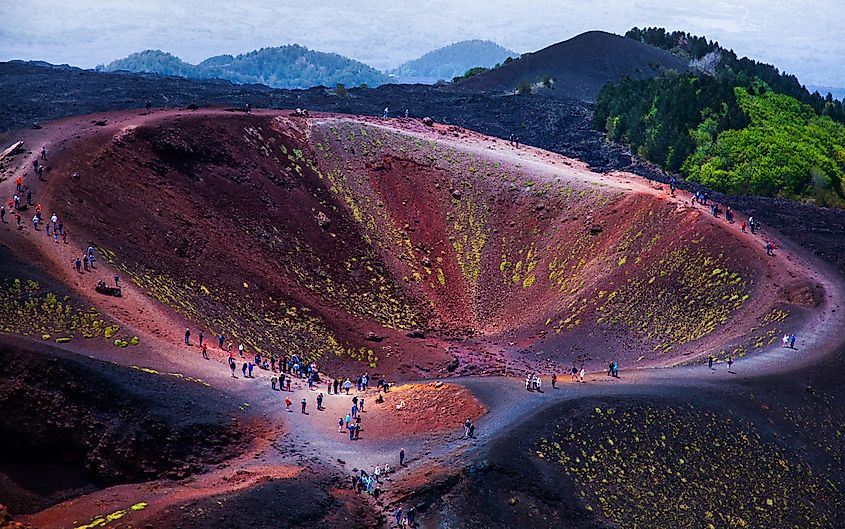
The spectacular sight of smoking craters and lava flows from Mount Etna has attracted philosophers, artists, poets, journalists, and travelers from all over the world. The Mount Etna World Heritage Site forms a part of the Parco dell’Etna Regional Nature Park and contains one of the most scientifically important and strictly protected areas of Mount Etna. The site’s tourism zones include a variety of accommodation options, restaurants, car parks, chair and drag lifts for ski tourism, ticket kiosks, and information options.
There are two principal points of departure for a trip to witness the majestic Mount Etna: One point is Mount Etna North Side, where you can get onto a platform located at 1800 m above sea level. You can also opt for the second point, i.e., Mount Etna South Side. Here at first, you have to take a car and reach the 1800 m mark, then get on to a cable car that will take you to the 2500 m level. From there, again, board a 4x4 bus that would take you to 2900 m, from which the summit craters are only a short hike away. During the thrilling cable car rides, one can witness picturesque panoramic views of Mount Etna and its surrounding areas.
In short, the summit craters, lava flows, cinder cones, and the Valle de Bove depression have made Mount Etna one of Sicily’s prime tourist attractions, attracting thousands of visitors annually. Mount Etna is also one of the world’s constantly monitored and best-studied volcanoes, with its notorieties as well as its scientific importance being globally recognized. So, next time on a trip to Sicily, take a Mount Etna guided tour and gaze in wonder at one of nature’s most magnificent creations.











